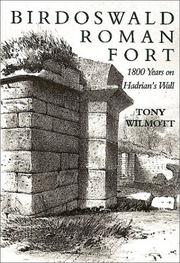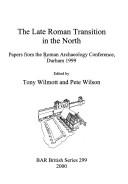| Listing 1 - 9 of 9 |
Sort by
|

ISBN: 0752419137 9780752419138 Year: 2001 Publisher: Stroud : Tempus,
Abstract | Keywords | Export | Availability | Bookmark
 Loading...
Loading...Choose an application
- Reference Manager
- EndNote
- RefWorks (Direct export to RefWorks)
Archeologische vindplaatsen. --- Classical antiquities. --- Excavations (Archaeology) --- Excavations (Archaeology). --- Hadrian's Wall (England). --- Hadrianuswal. --- Lager --- Romans --- Romans. --- Romeinen (volk). --- Römerzeit. --- Birdoswald (England) --- Birdoswald Site (England). --- Birdoswald. --- England --- Antiquities, Roman. --- History.
Book
ISBN: 9781407304267 1407304267 Year: 2009 Volume: 1946 Publisher: Oxford Archaeopress
Abstract | Keywords | Export | Availability | Bookmark
 Loading...
Loading...Choose an application
- Reference Manager
- EndNote
- RefWorks (Direct export to RefWorks)
Amphitheaters --- Architecture, Roman --- Amphithéâtres --- Architecture romaine --- Congresses. --- Congrès --- Amphithéâtres --- Congrès
Book
ISBN: 9781905624713 1905624719 Year: 2009 Publisher: Swindon English Heritage
Abstract | Keywords | Export | Availability | Bookmark
 Loading...
Loading...Choose an application
- Reference Manager
- EndNote
- RefWorks (Direct export to RefWorks)
From 1976 to 2000, English Heritage archaeologists undertook excavation and other research on Hadrian's Wall, firstly as rescue excavation, later for research and management purposes. This book begins with a brief account of these works, and this collection of reports completes their publication.
Excavations (Archaeology) --- Fortification, Roman --- Fouilles (Archéologie) --- Fortifications romaines --- History --- Histoire --- Hadrian's Wall (England) --- Great Britain --- England --- Mur d'Hadrien (Angleterre) --- Grande-Bretagne --- Angleterre --- Antiquities, Roman --- Antiquités romaines --- Fouilles (Archéologie) --- Antiquités romaines
Book
ISBN: 185074646X 9781850746461 Year: 1997 Publisher: London : English Heritage,
Abstract | Keywords | Export | Availability | Bookmark
 Loading...
Loading...Choose an application
- Reference Manager
- EndNote
- RefWorks (Direct export to RefWorks)
Birdoswald, built on a high spur between the River Irthing and Midgeholme Moss, was the eleventh fort from the east end of Hadrian's Wall. The antiquarian Reginald Bainbrigg described its 'great ruynes' in 1599, but archaeological excavations only began in 1850. Later excavations include work by Francis Haverfield, F G Simpson and Ian Richmond. The 1987-92 excavations directed by Tony Wilmott and reported here explored a long and complex stratified sequence dating from the second to the twentieth centuries. Work concentrated on buildings either side of the via principalis, but also included investigation of the northern defences and the eastern wall at the porta quintana dextra. The earliest human activity at Birdoswald was to clear the dense woodlands before building the Turf Wall and turret 49b in the early 120s AD, and a construction camp on the river promontory. These structures were replaced by a turf and timber fort and then a stone fort, which underwent numerous additions and changes in the second to fourth centuries, including periods of desertion and reoccupation. In the late fourth or early fifth century, the south horreum was modified and became the hall-like focus of a defended community. The building was replaced by a succession of timber halls built on or near the north horreum until the site was abandoned c 520, a sequence that provides a model for the sub-Roman development of communities at northern and western forts of the British Diocese. Reoccupation began in the thirteenth century, when a tower was built. After its collapse in the sixteenth century, a bastle house was built as the centre of a farming settlement, attacked three times by the reivers of Liddesdale. Scientific evidence, including specialised studies of pollen, soil and bone played a crucial role in interpreting the sequence of construction and the nature of the settlement at Birdoswald. With skill and care, Tony Wilmott has integrated the archaeological, historical and scientific evidence contributed by numerous experts to reconstruct the life of the Roman fort and its later uses
Romans --- Excavations (Archaeology) --- Birdoswald Site (England) --- Birdoswald (England) --- Antiquities, Roman. --- Birdoswald Site (England). --- Fortification, Roman --- Hadrian's Wall (England) --- Fortification, Roman. --- Fortifications romaines --- England --- Fouilles (Archéologie) --- Birdoswald (Angleterre: Site archéologique) --- Mur d'Hadrien (Angleterre) --- Angleterre --- Antiquities, Roman --- Antiquités romaines --- Fouilles (Archéologie) --- Birdoswald (Angleterre: Site archéologique) --- Antiquités romaines
Book
ISBN: 1848021585 Year: 2012 Publisher: Swindon : English Heritage,
Abstract | Keywords | Export | Availability | Bookmark
 Loading...
Loading...Choose an application
- Reference Manager
- EndNote
- RefWorks (Direct export to RefWorks)
From 1976 to 2000 English Heritage archaeologists undertook excavation and research on Hadrian's Wall. This book reports on these findings and includes the first publication, of the James Irwin Coates archive of drawings of Hadrian' Wall made in 1877?96.

ISBN: 1841710636 Year: 2000 Publisher: Oxford : Archaeopress,
Abstract | Keywords | Export | Availability | Bookmark
 Loading...
Loading...Choose an application
- Reference Manager
- EndNote
- RefWorks (Direct export to RefWorks)
Book
ISBN: 1785707450 1785707477 9781785707452 9781785707476 1785707442 9781785707445 Year: 2018 Publisher: Oxford ; Philadelphia : Oxbow Books,
Abstract | Keywords | Export | Availability | Bookmark
 Loading...
Loading...Choose an application
- Reference Manager
- EndNote
- RefWorks (Direct export to RefWorks)
"This is the first of two volumes dealing with the major research excavations on the Chester Amphitheatre in 2004-2006. The amphitheatre was discovered in 1929 and partially excavated in the 1970s, after which the northern half was laid out as a public monument. This fully integrated volume tells the story of the site from the Mesolithic to the end of the life of the amphitheatre. It contains full stratigraphic and structural detail, including CGI reconstruction of Amphitheatre 2, artefactual and ecofactual evidence, and takes account of the findings of all excavations on the site since 1929. A second volume will deal with the robbing and reuse of the amphitheatre in the post Roman period, and the development of the medieval and post-medieval urban landscape of the site"--
Amphitheaters --- Excavations (Archaeology) --- Archaeological digs --- Archaeological excavations --- Digs (Archaeology) --- Excavation sites (Archaeology) --- Ruins --- Sites, Excavation (Archaeology) --- Archaeology --- Coliseums --- Theaters --- Outdoor concert facilities --- Chester (England) --- Chester (Cheshire) --- Deva (England) --- Cheshire West and Chester (England) --- Antiquities, Roman. --- Material culture
Book
ISBN: 1803273054 Year: 2022 Publisher: Archaeopress Publishing Ltd
Abstract | Keywords | Export | Availability | Bookmark
 Loading...
Loading...Choose an application
- Reference Manager
- EndNote
- RefWorks (Direct export to RefWorks)
The North Sea and Channel coasts form the geographic frontier of the Roman Empire with the sea - the edge of the then known world. This border represents a page in military maritime history, but its coasts, in Great Britain, the Netherlands, Belgium and France, contain archaeological sites of high heritage value that deserve a large audience.
Military history, Ancient. --- Boundaries. --- Classical antiquities. --- 30 B.C.-640 A.D. --- Europe, Northern --- Rome --- North Sea --- Atlantic Ocean --- Northern Europe. --- Rome (Empire) --- Britannicum Mare. --- Antiquities, Roman. --- History. --- History, Military. --- Ancient military history --- Antiquities, Classical --- Antiquities, Grecian --- Antiquities, Roman --- Archaeology, Classical --- Classical archaeology --- Roman antiquities --- Antiquities --- Archaeological museums and collections --- Art, Ancient --- Classical philology --- Borders (Geography) --- Boundary lines --- Frontiers --- Geographical boundaries --- International boundaries --- Lines, Boundary --- Natural boundaries --- Perimeters (Boundaries) --- Political boundaries --- Borderlands --- Territory, National --- Northern Europe --- Rim --- Roman Empire --- Roman Republic --- Romi (Empire) --- Byzantine Empire --- Italy --- History
Book
ISBN: 9781803273044 1803273046 1803273054 Year: 2022 Publisher: Oxford : Archaeopress,
Abstract | Keywords | Export | Availability | Bookmark
 Loading...
Loading...Choose an application
- Reference Manager
- EndNote
- RefWorks (Direct export to RefWorks)
| Listing 1 - 9 of 9 |
Sort by
|

 Search
Search Feedback
Feedback About UniCat
About UniCat  Help
Help News
News